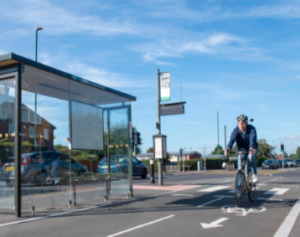Transport for London has announced that 18 pedestrian crossings are being introduced that will give pedestrians priority and only change to let traffic through when traffic approaches.
These will be in place by the end of June and, says TfL, will help make the capital’s transport network even more sustainable and support a green recovery from the coronavirus pandemic.
‘Green Person Authority’ traffic signals are being introduced across the capital, which are configured to show a green signal to pedestrians continuously.
The signals show this green light until a vehicle is detected, making it easier for people to cross the road, enabling more journeys on foot.
‘Green Person Authority’ has now been delivered at seven locations in Tower Hamlets, Newham, Hounslow, Richmond and Hillingdon and will be installed at a further 11 locations over the coming weeks.
The number of journeys made on foot has hugely increased throughout the pandemic, with TfL data from earlier this year showing that 31% of Londoners say they are walking to places where they used to travel by a different mode, and 57% say they now go on more walks for exercise or walk for longer than they did before.
At one point last year, the number of journeys made on foot increased from 35% of journeys to almost 50%. The new traffic signals will further enable people to travel around the capital this way.
TfL says a number of factors have influenced the signal locations, including high pedestrian flow, proximity to pedestrian destinations such as shopping centres, stations and schools, and suitability of existing technology. It adds that it continues to identify new locations where ‘Green Person Authority’ crossings can be introduced, with the aim of increasing their number over the coming years.
Meanwhile TfL has also recently extended its Lane Rental scheme to charge for roadworks on 20 of the capital’s footways. TfL has introduced a charge of £350 per day for works that impact on the busiest areas of pavement in the capital, to minimise disruption to people walking.
It says people walking, particularly those with accessibility needs, can be badly impacted by pavements being dug up, especially at the busiest times.
The Lane Rental scheme allows TfL to charge utility companies and infrastructure providers a daily fee for digging up the busiest sections of London’s roads at the busiest times. It’s aimed at encouraging companies to plan their works outside of the most sensitive times. All money raised from the scheme is then reinvested in initiatives and innovations designed to reduce the congestion and disruption caused by roadworks across the capital.
Will Norman, London’s Walking and Cycling Commissioner, said, ‘Walking has so many benefits – it doesn’t just enable us to get from A to B, but also improves our mental and physical health. We know that safety is a key concern for people walking around London, and giving pedestrians priority is a powerful way of putting them first and making it easier to cross London’s roads. By combining this with creating extra pavement space and ensuring roadworks are carried out in a way that doesn’t disrupt Londoners, we will make our city the world’s most walkable and eradicate collisions on our streets.’
(Picture – Yay Images)
Nick Owen, TfL’s Head of Network Performance, said: ‘We know that walking is a brilliant way for people to make local journeys, boosting activity levels while cutting the number of car trips and the associated congestion and pollution they can cause.
‘We’re determined to make it easier for people to cross the road and to give people the space they need to walk safely, and these initiatives will make a difference in enabling more people to access local high streets, shops and other businesses in a sustainable way.’
Mary Creagh, Chief Executive, Living Streets said: ‘Everybody should be able to cross the road safely, directly and without delay. Putting pedestrians first at crossings will make streets safer for everyone.
‘This exciting initiative to switch to a default green person gives power back to pedestrians, helping them move around more easily, safely and quickly.’






















